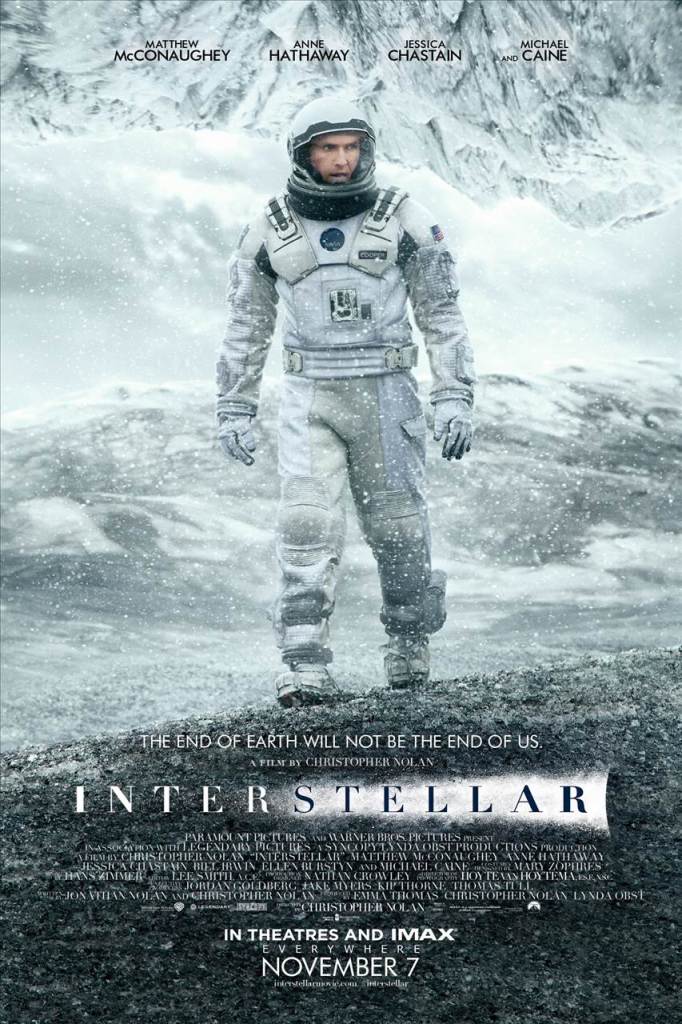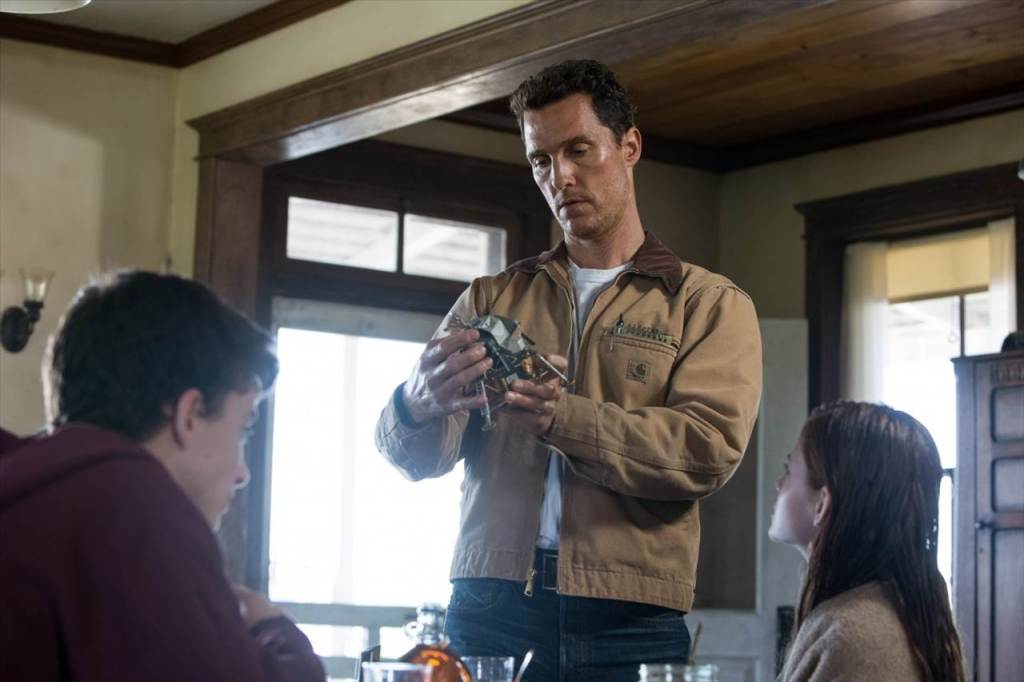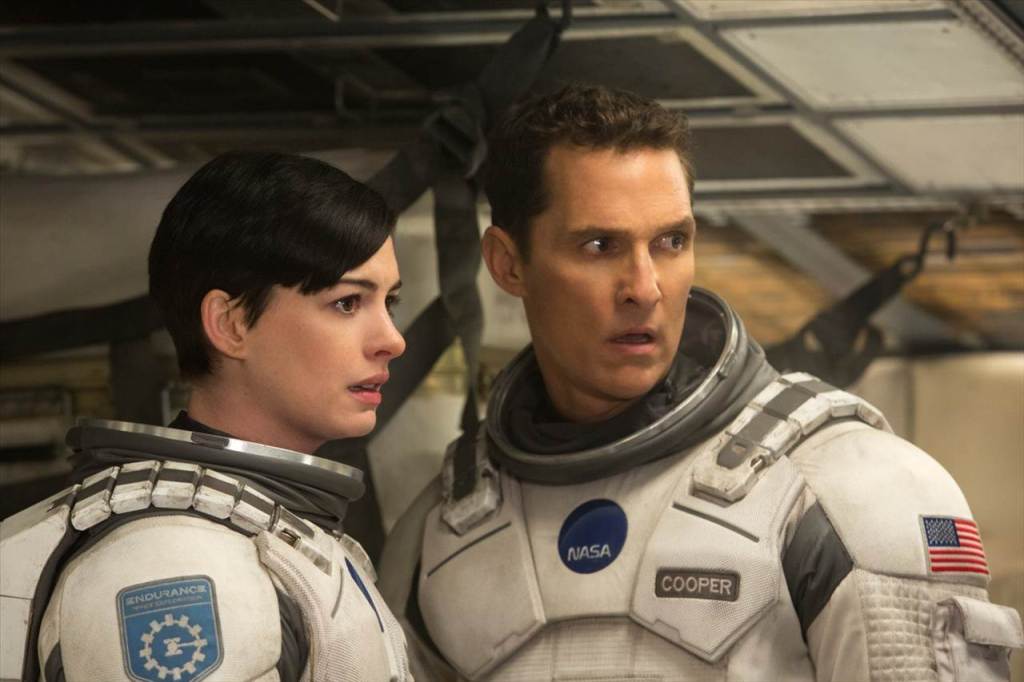BOOM! CRASH! POW! OUTER SPACE! SILENCE! WORMHOLES! ALIEN PLANETS! DANGER! BLACK HOLES! BLARING MUSIC! RUMBLING BASS! MCCONAUGHEY!
“Interstellar.”
That’s the first impression that this movie leaves you with, as it is 169 minutes of bombast, big scientific ideas, huge human emotions and visual depictions of space and space travel never been seen in a movie (or anywhere else really). This is a huge movie in scope and size, earnest in its emotional, very human story but also desiring to leave the audience in awe of the breadth of vision of the film makers as well as the magnitude of the ideas that have been bandied about by the characters. After all, it’s not every $160 million dollar budgeted movie that has major plot points revolving around the relative nature of time throughout the cosmos and the existence of dimensions beyond the three that we as humans and observers of the world around us can even understand.
Made with much assistance of legendary theoretical physicist (and executive producer of the film) Kip Thorne, this is a science fiction movie that cares more about science facts than making up crazy stories about aliens and space travel and talking robots (though there ARE talking robots in this). Black Holes are real things in our universe and can be expected to act in certain ways and to be depicted in certain ways because science. Wormholes are theoretical, but it is theory founded in real science. And in this movie these things are treated as such, with reverence and respect for what they are and what they represent. And the fact that the Brothers Nolan (writer/director Christopher and writer Jonathan) found a way to take these things and tell a compelling, human story is pretty incredible. It’s not a bunch of boring space facts with no connection to the story and it’s not a bunch of made up shit to push the plot forward, it is a movie about the effects of time, which is treated here differently than it has in any movie, as it is much more tangible and relevant here than any other movie, it is a resource, a depleting resource, one that can be used and abused and misused and as such has a very heavy, weighty effect on what happens at every point in this story. That is pretty remarkable.
This story starts off several generations from now, on an Earth ravaged by an unnamed blight, leaving the few who have survived with only corn to sustain on, and even that is about to become unsustainable. North America at the very least is back to Dust Bowl conditions, with dust storms rolling through and fucking everything up royally like woah. They even got people who survived the real Dust Bowl of the 1930’s to describe conditions at that time and what life was life, and played it like they were talking about the time period in this movie. Pretty clever, you guys. Cooper (Matthew McConaughey) is a test pilot turned corn farmer who stumbles across an opportunity to pilot a secret mission to outer space, simultaneously scratching an itch he never got to scratch thanks to the aforementioned agricultural apocalypse and also embarking on a chance to help save the human race. That’s a pretty cool proposition, no matter who you are. You gotta be a real objectivist asshole of the highest order to scoff at the opportunity to save the world, or at the very least the people on it.
But then he has this problem in that he has two kids whom he’s raising with the help of his father-in-law (an always welcome John Lithgow) and going on this mission means he has to be away from his kids for a very long time. Making it worse, it is an unspecified amount of time, and there’s the sad but inevitable moment (inevitable because we’ve seen the trailers for this movie, we all know already he’s going into outer god damned space) in which he says goodbye to kids, and his 10-year old daughter Murphy refuses to say goodbye to him or respond to him in protest of him leaving, which he does, and her silence and anger propels much of the emotion of this movie, along with Coop’s guilt over leaving his family behind, albeit in an effort to provide them with full lives for themselves and their own kids, either on Earth or somewhere else. So when the video messages start rolling in, expect a lot of emotions and people trying not to cry and then crying of course.
Which makes this easily the most emotional and warm of all of Christopher Nolan’s movies. His films have of the Kubrick or Fincher touch, in that goopy sentimentality and lots of crying and declarations of love and betrayal are usually replaced with calculated portrayals, almost academic presentations of human interactions, as if observing them in a lab experiment. But with “Interstellar,” for the first time Nolan is working in what can be deemed Steven Spielberg’s territory, with a story about a kid who feels abandoned and a guilt-riddled father and the love that they have for each other and what that love means. Nolan has made huge budgeted movies that have been seen and loved by lots of people, but this is his first time making one of these movies with the intention of it appealing to everyone.
Not surprising, this movie was originally developed by Jonathan Nolan for Steven Spielberg to direct, so the comparison is obviously more than apt.
And even then, as the movie gets into the final hour, the story takes a couple of twists and turns that bring to mind other directors like Brian de Palma and Ridley Scott and even M. Night Shyamalan, and there is a sequence in this movie, a very important one, that makes me wonder it is will lose a portion of the audience because of how weird and frankly theoretical it gets, both in terms of what is happening in the story and how it is visually represented on screen, because believe me when I tell you, it gets weird. But also fascinating and bold and beautiful. This is the kind of original, event film making that people complain about not getting anymore. Even if you see this movie and don’t like it, you will know you’ve seen something you haven’t seen before. Sure it has the fingerprints of the films which influenced the Nolans in creating this thing but they, like the best artists, took their influences and made some unique with their own voices, something which itself will go on to influence and change and effect the way movies are made for years to come.
Technically speaking this is definitely movie worth seeing on the big screen, and here is a list of different formats in which you can see this movie throughout the country. I was able to see an IMAX Digital screening (as opposed to the preferred 70 mm film presentation), however at least it was on 60-foot tall screen with 10,000 watts of sound, all of which were used for this very loud movie. As a matter of fact, several scenes had the music so loud and the bass so rumbly that it nearly drowned out the dialogue, though not completely. Now there have been reports of some screenings with inaudible dialogue due to the sound mixing issues, but fortunately for myself this was not a problem at my screening though it came close here and there. Otherwise, the sound cranked up like that was a good thing because they managed to make my seat rumble and shake with the sound of their spaceship lifting off and that is damn impressive.
Big ideas and big emotions. That’s “Interstellar.” It may not be perfect, but it is earnest and made with compassion, even in the face of unnerving odds and dire consequences. The hope of humanity as it plunges through a black hole. Surely it will be torn apart. But maybe, we hope, it won’t?
Want a much more detailed and spoiler-filled discussion of this movie? Then check out our “Interstellar” bonus spoiler episode of Cinema Crespodiso.




 #156 – That’s My Dog!
#156 – That’s My Dog! Bonus Episode – The Epic Off Cuts Crossover Event
Bonus Episode – The Epic Off Cuts Crossover Event #309 – Martial Science
#309 – Martial Science #220 – Slinging That ‘Tent
#220 – Slinging That ‘Tent
Leave a Reply
You must be logged in to post a comment.